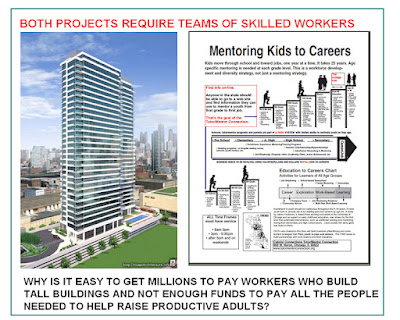 A few years ago one of the NU Public Interest Program Fellows who was working with me at the time, created a graphic, that looks like an iceberg. You can see it here. Today I updated that graphic (crudely). You can see it at the left.
A few years ago one of the NU Public Interest Program Fellows who was working with me at the time, created a graphic, that looks like an iceberg. You can see it here. Today I updated that graphic (crudely). You can see it at the left.In my new version, I included photos of teens and volunteers who were part of the Cabrini Connections program that I led between 1993 and 2011. Many joined us while in 7th or 8th grade and stayed involved through high school. I'm still connected to some via Facebook and LinkedIn.
I also added a tagcloud I created last week, that shows the many different areas of knowledge program leaders should be thinking about as they look for ways to build and sustain long-term, mentor-rich programs. These tags can be seen on the left side of this page. However, there are many other places on the Internet where I've been sharing these ideas.

In the graphic at the right I've created "oil well" graphics, and put them on a map of Chicago, where the red color represents areas of high poverty. The "oil well" and the "iceberg" are two related ideas. Strong programs don't start out great. They become great over a period of years, as a result of constant reinvestment of ideas, dollars, time and lessons learned. They are needed in every poverty neighborhood.
Below is a third graphic, where I compare raising a child to building a house or a tall building. You start with a plan, with financing, and with blueprints. Then you do the work shown on page one before you go to page 2. You work your way from the bottom to the top. Kids grow from birth to work. They need many different types of learning support as they grow up, and they need help from many different people as they move from school and into work.
Actually, as a parent, with children aged 19 and 26, you don't usually have a plan. You learn as you go. You hope you can find the money. That could be the topic of an entirely different blog.
I'd like to see more people involved in mentoring, from the national level down to the city level, integrating maps and visualizations like these and the strategy map below, showing the infrastructure needed in many different programs, while showing that great programs are needed in many different places. And, showing that the long-term goal is that kids who come through our programs are entering the workforce in their mid-twenties, thus able to earn a living that allows them to raise their own kids free from the challenges of concentrated, segregated, urban or rural poverty.
This map also shows the commitment needed by leaders from business, faith groups, colleges, hospitals, celebrities, media, politicians, etc., who must become more proactive and on-going in their commitments, if great programs are going to be available in more of the places where they are needed.
This graphic is from this article, and illustrates the need to use ideas to influence resource providers as well as non-profit leaders.
I've just shown you a few of hundreds of visualizations I've created over the past 20 years, all with a goal of enlisting more people in efforts that make programs available which help kids born or living in high poverty neighborhoods today, be in jobs/careers in 25-30 years.
For that to happen, many more people need to be talking about the same ideas that I am communicating through my blog articles. If that is happening, you should be able to do a Google search for the organization or business and then see many similar visualizations when you look at the images feature on Google. Try it.
If you're using graphics to communicate similar ideas, please post a link to your web site in the comments section below and let's connect. If you'd like to know more about how you might get involved with this work, just introduce yourself to me in an email to tutormentor2@earthlink.net or a post on Twitter or Facebook.
6-10-2025 update - here's an article from Social Roots that shows the value of intermediaries who do the type of work I've been trying to do for the past 32 years. It's titled: Self-Organization Needs Activators: The 9% Who Turn Networks into Movements click here











No comments:
Post a Comment